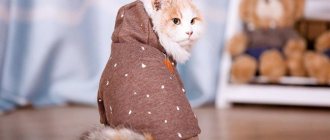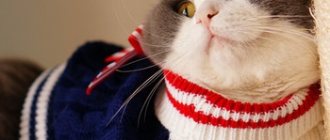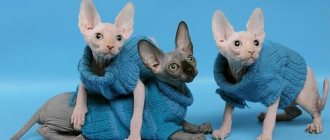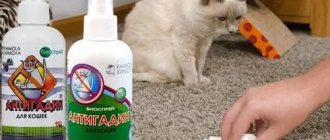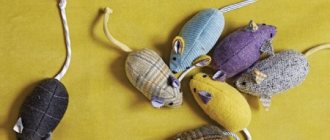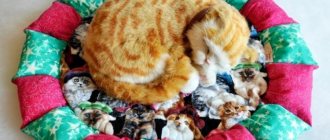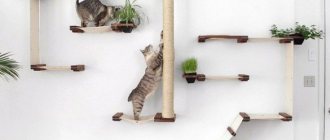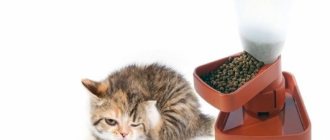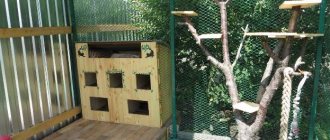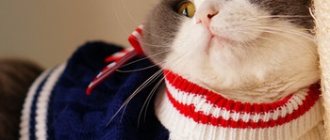04.11.2019 Pet supplies Share
Does a cat need clothes? Yes, definitely! We offer to sew clothes for a cat using a universal pattern. Using it, taking into account the individual size of your cat, you can sew or knit any item for it. Many cats need clothing, because not all breeds have thick fur; many do not have it (Cornish Rex, Canadian Sphynx, Don Sphynx, etc.). If the apartment is cold and the cat (with fur) is freezing and climbs into your arms, then you need to sew clothes for the cat.
To make your cat like clothes, animal psychologists advise:
- Start accustoming your cat to clothes at an early age.
- You need to be patient, cats don’t immediately get used to clothes.
- Reward your cat with affection or a tasty treat for the courage shown in trying on and wearing an outfit.
- Cat clothes should not be worn every day; cats do not like stiffness in their movements.
Sew
Step-by-step instruction:
- Choose your favorite cat clothing model and transfer all the details of the product onto checkered paper (graph paper).
- Cut out each piece and attach it to a separate sheet of paper, large enough to make the piece of clothing in natural size.
- Check if the pattern is the right size for your cat and adjust the pattern according to the measurements taken.
- Cut out the parts and secure them with tape.
- Try the blank on the animal and, if necessary, adjust the model.
- Wash and iron the clothing fabric.
- Lay out the prepared clothing pieces on the fabric, starting with the largest elements.
- Secure the templates with pins, transfer the design of the details onto the fabric using a piece of soap or chalk.
- Cut out the pattern with sharp scissors.
- Sweep the finished parts with contrasting threads and try them on a cat. If the outfit fits perfectly on the figure of the tailed fashionista, then proceed to the final connection of the parts.
- Apply braid to the neckline, armhole and bottom of the garment.
- At the final stage, sew on the clasp and decorate the outfit to your liking.
This option is suitable for kittens or small cats. For an adult cat, use the sleeve of your old sweater or a baby fleece pajama leg. This material does not crumble, which means there is no need for additional processing of the seams.
Types of suits
Do-it-yourself scratching post for cats: options at home
Clothes for cats come in different forms and are divided according to their appearance and purpose. Therefore, when choosing suits, it is recommended to take into account the purpose of use and some features.
For many cats, clothing is a way to protect themselves from the cold.
Winter
Winter clothing is designed to protect pets from freezing and hypothermia. Insulated overalls are well suited for this purpose - a one-piece suit with cutouts for the head, tail and paws. You can choose a good warm jacket that covers most of the body. For those cats whose paws are cold, it is recommended to choose insulated soft boots and socks.
Demi-season
Demi-season clothing is used in autumn and spring
At this time of year there is quite often rain and slush, so you should pay attention to the quality of the fabric. It should not allow moisture to pass through, but at the same time breathe well.
Important! Demi-season suits should be easy to clean
Important! Demi-season suits should be easy to clean
Summer
Clothes for the warmest season should be made of light and natural fabrics that are well breathable. These outfits are used to protect the animal's delicate skin from sunburn. A properly selected outfit will also allow your pet to avoid overheating in hot weather.
Casual
Casual outfits are required for cats that lack warm fur. Such animals often get cold even on cool summer evenings, so they need suits to avoid hypothermia and get sick. It is recommended to choose clothes made from natural fabrics so that your pet feels comfortable.
Festive
Clothes for holidays are usually very elegant and original.
Interesting costumes are used for exhibitions and competitions, thus often attracting the attention of judges. Such outfits are made from beautiful fabrics and decorated with lace, embroidery, rhinestones and stones. Dresses for exhibitions are always distinguished by an abundance of decorative elements
Dresses for exhibitions are always distinguished by an abundance of decorative elements
Protective
Items from this group are great for protecting pets from harmful insects and ticks. They also need to be treated with special products, but wearing such clothes for a cat significantly reduces the risk of bites from fleas, ticks and other pests.
Decorative
Decorative clothing, like festive clothing, is required only in certain cases - exhibitions, holidays. In most cases, cats don’t particularly like it because it is not soft and cozy, but has a lot of decoration. But cat owners still use these things in some situations.
Important! Before buying cat clothes, you need to decide on the purpose of its use, and then consider the options. You can also decorate a cat for a holiday. You can also decorate a cat for a holiday
You can also decorate a cat for a holiday
Clothes without a pattern (from the sleeve of an old sweater)
An express option for making a warm outfit for a cat or kitten will be useful for those who have zero sewing skills and do not know how to make patterns. It will also help out when it gets very cold and you urgently need to come up with some temporary clothes for a freezing cat. The starting material for such a quick production kit is old sweaters made of thick knitwear, fleece sweatshirts or children's pants.
Knitwear and fleece retain heat perfectly and have sufficient elasticity, thanks to which clothes made without a pattern will perfectly fit the pet’s body. Before you start making clothes, you need to make sure that the selected material is soft and will not ripple.
Stages of work:
- Using a measuring tape along the back, measure the distance between the cat’s front paws, as well as the length from the top of the neck to the interscapular fossa;
- measure the length of the back from the neck to the base of the tail;
- lay out the cut sleeve or trouser leg on the table, smooth out all the folds;
- step back horizontally along the upper edge to the level of the shoulder blades and lower vertically by half the measured distance between the paws, and then draw a horizontal line on the fabric approximately equal to the half-circumference of the paw in its upper part;
- Using sharp scissors, cut both layers of fabric at the marked location;
- Mark the length of the back along the upper edge of the sleeve and cut off the excess, making a bevel so that the length of the tummy is approximately 10 cm shorter than the back;
- try the product on the cat, then, if necessary, adjust the holes for the front paws and narrow the back part using darts or by placing the edge on an elastic band;
- If necessary, overcast the holes for the paws and the back cut.
Which fabric to choose?
If you want to make clothes for your cat yourself, use natural fabrics with no electrostatic effect.
100% cotton does not cause allergies, has good performance properties, practically does not shrink, can be boiled, and does not fade.
Viscose has the same properties as cotton. In addition, it is elastic, stretches well, and does not lose its shape. But it has restrictions on the water temperature when washing.
100% wool warms well and, with proper care, does not shrink or shed. Not suitable for sensitive skin due to tartness. If you want to use a woolen product, it is better to choose mixed fabrics - 70% wool, 30% viscose.
Polyester fabrics are soft, elastic, retain heat well, but can accumulate electrostatic voltage, which cats, especially long-haired ones, will not like. Using special treatment for artificial fabrics, it is possible to get rid of the electrical effect.
Features of sewing clothes for cats
One of the features of sewing clothes for cats is the choice of materials. Everything here is very individual, since this particular fabric and this particular style will suit each individual cat. And it’s not just about the breed, but also about the coloring of the pet’s coat, the size of the pet, and even the place it occupies in the owner’s heart.
Cat apron
In any case, special attention should be paid to natural materials. It is also possible to use fabrics with a small amount of synthetic fibers
The best option would be: cotton fabrics, linen, wool, viscose. They are pleasant not only for humans, but also for cats. You should also look at the characteristics of the material: how well it is made, whether it fades in the sun, or whether it deforms after washing.
Bow and dress
Also among the features is taking measurements of cats, which, naturally, differ from dogs, and even more so from humans. Taking measurements from animals is not so easy, since they constantly strive to break free.
McDonald's apron version
What to make for your pet
Cat fashion is different from human trends. It is not beauty that should come to the fore, but the convenience of the outfit. And only after ensuring the animal’s comfort can we proceed to beauty care.
First of all, clothes should be comfortable
When sewing clothes for cats, you need to build on three basic requirements:
- quality. The outfit should be as natural as possible. It is better not to use synthetic fabrics and other dubious products for sewing;
- simplicity. The costume should not consist of a dozen parts in which the animal will become entangled;
- comfort. Even in overalls, the cat remains a predator that needs to hunt, run and jump. The outfit should not hinder the movements of the fashionista.
When choosing an outfit for a cat, the owner should pay attention to the most popular items of the tailed wardrobe.
Table 1. Types of clothing for cats
| Outfit element | Image | Benefit |
| Overalls | Protects your cat from cold and dirt while walking | |
| Sweater | Warms a bald cat on cold winter evenings | |
| Mike | Lightweight outfit for the off-season | |
| Dress | Decoration for a thoroughbred lady | |
| Skirt | An element that gives the cat a feminine look |
As a rule, cats do not need hats or shoes. In addition, it will take a long time to accustom them to such outfits.
Vest without pattern
To sew a vest for a cat, it is not necessary to draw complex patterns. All you need is an old sweater, scissors and some creative inspiration. The model in the picture shows a dog, but the proposed accessory is perfect for a cat of any breed.
Clothing suitable for both cats and miniature dogs
The step-by-step production of such a vest is presented below:
- the sleeve is cut off from a knitted sweater;
- draw a curved line with chalk next to the cut - on the stomach the vest should be shorter than on the back;
- cut off the excess along the marked line and overcast the edge. You can use either an overlocked hand stitch or an overlock stitch;
- The future vest is applied to the animal and the location of the holes for the paws is marked. The closer to the narrow edge the holes are made, the smaller the vest collar will be;
- Having folded the sleeve in half, reflect the marks for the holes symmetrically and cut them out. You can overcast the edge in any way.
After fitting, the craft is adjusted. If necessary, it can be sutured.
Airy skirt
Clothes for cats are needed not only to keep your pet warm, but also for going out into the world. Thus, show animals often appear before judges in exclusive outfits. Skirts are especially relevant in cat fashion, giving femininity and charm to sophisticated breeds.
To create such an unusual accessory you will need:
- tulle;
- satin ribbon;
- scissors.
The easiest way to create a fluffy ballet tutu does not require any drawings or patterns. To sew a skirt, just measure the cat’s “waist” circumference and add 10 cm to this value.
Required materials and work process
The satin ribbon is cut to the obtained length. The tulle is cut into strips 2 cm wide. The length of the strips is equal to the required length of the skirt multiplied by 2.
Next, the tulle strips are folded in half and tied onto a satin ribbon with loose knots, as shown in the photo. The thicker the ribbons are tied, the more magnificent the pack will be. To add volume to the product, the length of the strips can be varied. To create color transitions, tulle of various shades is used.
How to cut and attach ribbons
When all the stripes are tied on a ribbon, the skirt is tried on the cat. The free ends of the tape are tied on the back of the animal and their length is adjusted.
Ready-made skirt
Sew clothes for a cat
- 1 How to take measurements
- 2 Pattern
- 3 Let's get started
Does a cat need clothes? Yes, definitely! We offer to sew clothes for a cat using a universal pattern. Using it, taking into account the individual size of your cat, you can sew or knit any item for it. Many cats need clothing, because not all breeds have thick fur; many do not have it (Cornish Rex, Canadian Sphynx, Don Sphynx, etc.). If the apartment is cold and the cat (with fur) is freezing and climbs into your arms, then you need to sew clothes for the cat.
To make your cat like clothes, animal psychologists advise:
- Start accustoming your cat to clothes at an early age.
- You need to be patient, cats don’t immediately get used to clothes.
- Reward your cat with affection or a tasty treat for the courage shown in trying on and wearing an outfit.
- Cat clothes should not be worn every day; cats do not like stiffness in their movements.
How to take measurements
- Neck circumference.
- The length of the cat from the beginning (base) of the neck to the base of the tail.
- Body circumference at its widest point
- Length of the torso along the abdomen.
- The girth of the front paw at the base (sleeve neckline).
- Abdominal girth.
For sewing clothes, it is better to take knitted fabrics, not necessarily new ones (an old knitted sweater will do). Knitwear is comfortable because it stretches well. If the item is made of knitwear, there must be a fastener on the back. If you knit, you don’t need a fastener, put the clothes on over your head.
Types of fasteners:
- With a zipper that can be easily sewn into the seam in the center of the back. Convenient for hairless cats.
- With buttons that fits all cats.
- With Velcro, which is suitable for hairless cats and cats with short hair.
- With buttons, suitable for all cats.
Pattern
This pattern is specially adjusted specifically for cats. We print the pattern on sheet A-4. Since not everyone can use a printer, the pattern is given in centimeters to make it easier to transfer it to paper.
Please note: the top part is 2 parts + the fastening allowance is 2-3 cm. The bottom part is a double part, when unfolded it turns out to be a belly
To work we need:
- knitted or woolen fabric.
- scotch
- pins
- scissors
- Velcro, zipper or buttons
- bar of soap
- paper
We have a drawn or printed pattern for a cat's clothing. Once you have taken your cat's measurements, try to see if the pattern will fit you. If it doesn’t fit, it’s okay, you can always adjust the pattern on paper.
We bend sheet A-4 in half so that the breast is made in 2 copies. We place the back pattern on paper. Trace and cut out. We take tape and fasten the sides and shoulders together. We have a blank, measure it for a cat. If you don’t need to redo it, remove the tape and straighten the pattern. We attach the pattern pieces to the fabric, secure with pins, and outline with a piece of soap. We cut out the parts, not forgetting about seam allowances and space for Velcro or buttons. Remove the pins and set aside the pattern. We sew Velcro to the back using a machine or by hand. Sew the shoulder and side seams. Next we need to finish the neckline, bottom and armholes. If you have knitwear, it is better to trim it with stripes from the same knitwear. If finishing is needed, a braid with an elastic band works well. Sew to the neckline, hem and armholes. The vest is ready.
We sew warm clothes for cats!
Summer minimalism
Cats only need casual outfits during the cold season. In summer there is no need for insulation, but there is a need for a stylish appearance. To add some flair to your cat's image, but not to overdo the outfit, you can make a cute accessory for your pet - a bow tie.
By the way! The textile highlight is also useful for photo shoots when the animal urgently needs to find a home or introduce the cat to the public.
Bow tie for a cat
For sewing you will need:
- thick fabric;
- collar (you can use a flea collar);
- needles, thread and scissors.
To ensure that the butterfly does not interfere with the cat’s enjoyment of life, you need to choose the appropriate size of the craft. Firstly, the product should not be too large. A bulky accessory will disturb the animal while eating and irritate it the rest of the day. Secondly, the craft should not have an intrusive smell, rustle or put pressure on the throat.
Step 1. Cut out a rectangle with sides 25 cm and 13 cm from thick fabric. It is also necessary to prepare a jumper for the butterfly. Its dimensions are 6x4 cm.
Tie details
Step 2. If the cat does not wear a collar, a strip of the same fabric will be useful for the tie, which will become a fastener. Its dimensions are 50x5 cm. A long piece of fabric is folded in half lengthwise and stitched. A fastener is attached to the ends of the tape.
Sew the main part for the bow tie
Step 3. A 25 cm piece is folded in half and stitched into a ring. Next, this part is folded so that the line is in the middle.
We sew a ribbon for a tie and sew on a hook
Step 4. A small jumper section is sewn into a miniature ring by hand, going around the main part. The butterfly is straightened and the jumper is secured in the middle of the craft with a hidden stitch from the inside. A part with clasps or a collar is inserted under the ribbon.
Video - Festive butterfly for a cat
We knit clothes for the sphinx with our own hands in a step-by-step tutorial
When choosing yarn, we monitor the composition of the threads; they should consist of natural substances and should not be electrified. Before work, measure the circumference of the cat’s neck and the approximate length of the product.
Necessary materials:
- Wool threads or half with acrylic 100 grams
- Knitting needles No. 3.5
- Circular knitting needles No. 3.5
- Needle for stitching
When knitting, follow the sample shown in the photo below, substituting your measurements if necessary. Keep in mind that the product should not be too tight and restrict movement, and should not sag, preventing its owner from moving.
Operating procedure.
Knitting density 16 loops x 20 rows in 10 x 10 cm
We start the process in front of the neck and follow the pattern; if the knitting density is different, adjust the number of loops to maintain the dimensions.
- We cast on 25 stitches on the knitting needles and knit 3 cm with a 1x1 elastic band (1k.x1p.).
- We continue to knit in stockinette stitch for 10 cm.
- On both sides, 13 cm from the edge, we cast on 18 stitches and knit 61 stitches for another 10 cm.
- For the cutout, close off 21 sts in the middle, and in the next row cast on 28 sts instead.
- Another 10 cm in stockinette stitch, and close off the outermost 18 stitches on both sides.
- The last 10 cm with the main pattern and again 3 cm with the same elastic band. We close the loops.
- Sew the side seams and sleeves.
- We cast on loops from the neckline on circular knitting needles and knit with a 2x2 elastic band (2 knits x 2 purls) the collar, if desired, is either short or with a turn-up, so that it is comfortable for the cat.
Here is the simplest option; of course, the main pattern can be changed at your discretion, you can combine the colors and shape of the product, in general, everything is in your hands.
Comfortable and stylish pajamas
Cats are heat-loving animals, especially if you have a Sphynx living in your apartment. Pets with smooth coats require special attention, so comfortable pajamas are the ideal solution for caring for your four-legged animal. For overalls, any soft fabric is suitable, for example, flannel, fleece or knitwear; it is better to use waterproof options. The pattern of this outfit for a cat is printed on A4 sheets or applied independently to whatman paper.
Step 1. This model consists of several parts. Part 1 – back (GZ), the value is equal to the length of the cat’s back; you can also place a fastener along this line (for this you need to leave an allowance of two to three centimeters). Detail 2 (IZ) – belly measurement, folded along the IZ line.
Step 2. Place the pieces together and sew. The lines AG, BV, VD, DE are sewn together, the rest remain free (AB and EZh are the paws). The ZhZ line also needs to be sewn, but leave a small hole for the tail. When the work is ready, sew on a zipper if desired.
Some tips for sewing: make the seams overlap, using a zig-zag stitch, in this case they will be softer and will not disturb your cat. The lower edges of the paws and throat can be supplemented with a pre-prepared knitted ribbon. If the pajamas are made from fleece, the fabric does not need to be improved in this way.
How to sew a bean bag for a cat
Designers always delight cat owners with new ideas, but they keep the patterns secret. Look at what an interesting cat bed - with ears and a tail, in the shape of a Cat.
Our free pattern will fit a medium size cat, but if your pet is larger than an average cat, increase the length of the pattern. The width should be enough for comfortable sleep. What to make a cat bed from with your own hands: natural fabrics are preferable.
The photo shows faux fur, but it’s better to take fabric from an old terry robe, or a couple of terry towels, denim, linen, or knitwear. Denim fabric will make, if not a bag, then a good mattress for a cat. Artificial fabrics, such as fleece, microfiber, flock, retain fat, sweat, moisture and do not “breathe”.
We also need foam rubber - it is needed for the lapel. The pattern has 1 cardboard piece 160 cm long. It is inserted inside the lining so that the sleeping bag is not so flat, but this is at your discretion - you don’t have to insert cardboard.
To work you will need:
- 2 main parts 58/48 cm each, for the lapel – 100/20 cm, for the ears and tail.
- 2 pieces of lining material, 58/48 cm each.
- Foam rubber for lapel – 100/10 cm.
- Threads, scissors, needle.
- Filling for stuffing the underside, ears and tail.
- Tailor's pins.
The pattern is given without seam allowances! A sewing machine is not necessary, but it will make it faster.
We measure out the required dimensions on paper, or directly on the wrong side of the fabric. Don't forget to add an allowance of 0.5-0.7 cm to the patterns.
We will start our master class with stitching together small parts. Take 4 ear pieces, fold them front to back in pairs and sew. Do not sew the bottom of the ears. Turn it out. The tail part can be made not as pointed as in the pattern; round both ends. Fold the tail piece in half and place it wrong side up.
Sew the side seam, leaving an unsewn section for stuffing, and turn it right side out. We stuff the filling inside - we need the ears and tail to be voluminous. We sew up the open edges through which we stuffed with a hidden seam.
Next, we take foam rubber (if there is no foam rubber, you can simply sew the lapel and fill it tightly with filler). We sew 20 cm of the lapel, we get a continuous part. We put the foam rubber on the wrong side of the lapel and sew it up with an “over the edge” seam. We got a “donut”.
Next, we will make the main sleeping bag. To do this, we fold 2 parts of the lining face to face and sew along the edge, retreating 0.7-1 cm. Turn it inside out. We fold the 2 main parts face to face, place the finished tail in the middle, and pin it together. Make sure that the tail is at the same distance from the edges. Sew along the wrong side, retreating 0.5 cm from the edge.
We got 2 bags - from the lining and from the main fabric. Place the lining bag into the main fabric bag, match the seams, and pin together. The seam is sewn at a distance of 0.7 cm from the edge, leaving 7 cm unstitched for turning inside out. We turn our sleeping bag inside out.
All that remains is to sew on the lapel. Find the middle of the finished lapel and mark the point with a pin. We place the ears at the same distance from this point. We pin it with pins. We sew the bag to the lapel with neat small stitches, including the ears. The master class is over. You can sew a small mattress for the bed and stuff it too.
On the video - how to make a cat bed from a sweater, master class:
DIY cat bed
Watch this video on YouTube
The tuxedo
You can sew a wonderful tuxedo for your cat as a stylish accessory. Using a simple pattern, you can make a jacket-cape that will not hinder movement and will give your pet comfort.
For work you will need the following materials:
- white fabric - an old T-shirt;
- black material - any piece of cotton of a suitable size;
- a piece of red felt;
- Velcro for fasteners;
- scissors, chalk and other tailor's little things.
Necessary materials for work
Step 1. To determine the length of the tailcoat, measure the length from the neck to the tail of the cat. A pattern of a white element is cut out of white fabric in accordance with the measurements. For convenience, use a fabric folded in half. You will need 2 of these parts.
Cutting out the details for the tailcoat
Step 2. The first white piece, folded in half, is applied to the black fabric. The dark element should not be the same size as the white one, as the jacket will end up being shorter than the shirt.
Cutting out parts from black fabric
Step 3. You can choose any shape of the vest itself. The main thing is that it is symmetrical.
Combining the details
Step 4. A tie is cut out of red fabric, and a collar is made from a white scrap.
Cut out and apply the tie and collar
Step 5. Next, the parts are sewn together in the following order:
- a tie with a collar is attached to the base;
- a vest is attached to the upper white part;
- the protruding part of the tie is sewn on top;
- Velcro is sewn to the elongated neck so that the upper part tightly covers the lower one.
Sew the parts and attach Velcro
Step 6. The future tailcoat will be attached to the pet’s neck and stomach. As a fastener, cut out a rectangular strip of black color and add 0.5 cm to its edges.
Making a fastener
Step 7. The resulting strap is sewn between two white parts of the tailcoat. The length of the belt is determined by the circumference of the pet's chest. It is best to adjust this length during fitting. The edge of the cut belt is lined up. Strong Velcro is sewn onto one end of the tape.
Sewing the tailcoat and fastening
Step 8. The second Velcro piece is sewn on the opposite side of the white piece inside out, as shown in the picture. The fastened strap will go around the animal's chest. To make the tailcoat look stylish, its edge can be ironed and stitched 1 mm from the edge.
Ready-made tuxedo
The finished tuxedo will serve as an excellent cape for a freezing Devon Rex.
Tools for work
In order for the final result to please you with its neat appearance, prepare the following materials and tools:
- Knitted or woolen fabric.
- Closing.
- Scissors.
- Needle and thread.
- Sewing machine.
- Pins.
- A piece of soap.
- Sheet of paper for layout.
- Scotch.
- Braid for neckline and armholes.
- Sample. Today on the Internet there are DIY cat clothes - the models are universal, and you can change them according to your discretion and the functionality of the model.
Advice from professionals
To properly sew clothes for your pet, you can refer to the recommendations of professionals. They will help you avoid serious mistakes, reduce the likelihood of any problems arising, and also quickly accustom your cat to new clothes and reduce its discomfort.
Basic recommendations:
- Cats of any breed do not like fabrics that emit an unpleasant odor or rustle at the slightest movement. Therefore, when choosing a wardrobe item for a cat, you should avoid such materials.
- When sewing clothes for a pet, you should use only materials of natural origin. Otherwise, contact with your pet's skin may cause an allergic reaction or more serious health problems.
- It is best to use synthetic winterizer as insulation. It is lightweight and perfectly maintains a comfortable temperature.
- The shade of the product should be chosen based on the color of the animal’s fur. In this case, you can use any option, since cats quickly get used to each of them.
- It is necessary to teach your cat to try on and wear clothes from an early age. This will help your pet get used to the new environment faster and reduce the risk of stress.
- In order for your cat to like a piece of clothing, you need to reward it regularly. His favorite treat is suitable for this, which he will receive immediately after trying the product.
- Cats feel discomfort when something disturbs them. For this reason, experts recommend wearing clothes only once or twice a week. Otherwise, the animal will be under constant stress, which will lead to the development of various diseases.
- Purchased or homemade clothing should be as comfortable as possible for your pet. In addition, it is important to control the weight of the product and not overload it with decorative elements.
- Accustoming a cat to a jacket, dress, robe or something else is quite difficult. Therefore, experts recommend that owners be patient and not punish their pets for refusing to try.
DIY cat or cat clothes are a good way to protect your pet and avoid big financial outlays. If everything is done correctly, the item will look beautiful and perform its function efficiently.
Material selection
Costumes made from fabrics purchased for this look great on sphinxes. But dresses made from the owners’ old sweaters are no less attractive. To avoid damaging your pets' skin, choose fabrics that do not accumulate static electricity when rubbed.
To understand whether the capricious Sphynx will like the fabric, you need to wash it with an odorless detergent, dry it and put it on the cat’s bed. If there is no excess, then you can sew clothes from it.
Sewing blankets from improvised materials
Below we will tell you how and from what you can make a blanket if you don’t have suitable materials and patterns at hand. No special cutting and sewing skills are required.
Cat costume
Pantyhose blanket
The simplest option, requiring virtually no resources. There is only one rule - you must use clean tights, since the animal needs sterility after surgery and sterilization. It is recommended to use tight-fitting tights that fit well on the cat's body.
Important! The blanket is made as follows: a piece of trouser leg 20 cm long is cut off and stretched over the cat's stomach. You can also make holes for the legs.
New Year's costume for the British
Sock blankets without ties
The product is made from socks or stockings in a similar way. Find the perfect sock and cut off the front to create a fabric tube. The cat's body presses into her, staring at her stomach.
For your information! The most remarkable thing is that even if there are no sizes suitable for your home, you can always buy clean and new socks at any clothing store for several tens of rubles.
Blanket for a cat from a baby bodysuit
Blanket from old children's clothes
Old children's clothes in the form of overalls and T-shirts are also suitable. You should choose something that fits comfortably and securely on your body. If you don’t have anything like this on hand, you can make a blanket from an ordinary sleeve of a children’s sweater that stretches well.
Fashionable outfit with a hood
Towel blankets
The most common option is to use a simple cotton towel. An incision of the required length is made and holes for the legs are drilled, based on the anatomical characteristics of the cat. Holes are made for the neck, legs and sometimes the tail. The final step is to create a cylinder by sewing on the ends of the towel or sewing on threads.
If the cat needs to be sterilized, then you need to buy a blanket
Post Views: 37
